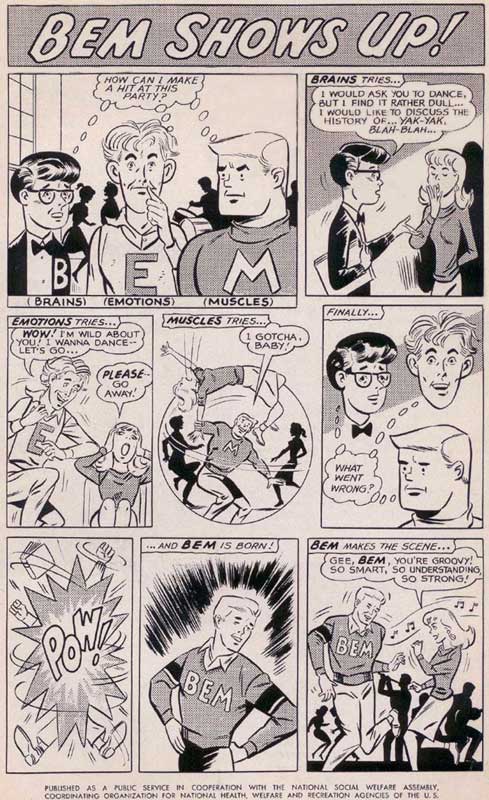Is There Ever a Second Chance at a First Impression of I.T.?
My parents named me Brent when I was born, but my older brother Steve as a toddler could only pronounce it as “Bem”, which stuck as my nickname over the years.

So imagine my surprise while waiting for a haircut circa 1967 at Russ’s Barber Shop in Salt Lake City. I was thumbing through a GI Joe comic book and noticed this “BEM Shows Up!” public service cartoon on the inside back cover. I tore it out discreetly and had it hanging on my bedroom wall for several years growing up. Decades later I re-discovered it thanks to the wonder of the web.
Brains, Emotions, and Muscles each failed miserably in making a positive first impression with the girl at the dance. In contrast, intelligent, empathetic, and able-bodied BEM totally made the scene. Groovy, baby.
First impressions are hard to shake, but it’s possible
Dorie Clark, a marketing strategist who teaches at Duke University’s Fuqua School of Business, writes in Harvard Business Review that initial impressions are hard to shake. “We’ve all been there—accidentally alienated a new coworker with a bad joke, underwhelmed the new boss by botching our first assignment, or had a client we just didn’t click with,” she writes. But, she says, “it’s not impossible to change how others view you.”
Clark offers four ways individuals can begin to overturn others’ entrenched beliefs, which I’ve shortened for the sake of blog brevity:
Surprise them
People don’t often change their initial impressions because the brain is optimized to conserve energy. If there’s no compelling reason to re-evaluate something, we won’t. You must manufacture a reason by surprising them.
Overcompensate over time
A forceful change in behavior may get your colleagues to take notice. But if you only do it once, they can write it off as an aberration. Instead, keep up your new behavior over time, and recognize that in order to change perceptions, you’ll need to do it far longer than the original behavior for which you were pigeonholed.
Get closer to them
If you’ve started out on the wrong foot with a colleague, it can be tempting to avoid the problem by staying away from them. But keeping a distance is likely to exacerbate the problem, because—since they’re not receiving any new inputs about who you are—it will only reinforce their existing perceptions. Instead, force yourself out of your comfort zone and find ways to get to know them better.
Wait it out
Finally, sometimes the bad impression your colleagues may have formed has literally nothing to do with you. If you’re patient and continue to act in ways you’re proud of, most people will eventually come around. While initial impressions tend to stick, they can—with time, effort, and strategy—be changed, so that your true talents can be appreciated.
Applying these tips to the world of IT service management
Unfortunately, people also have entrenched beliefs about the services their IT department provides, yet these beliefs can also be changed with time, effort, and strategy.
In the eBook “Five Ways to Modernize IT Service Management,” you’ll discover that the first section is devoted to fostering business relationships. The eBook’s author, Ivanti director of product marketing Melanie Karunaratne, states:
“Remember that every interaction with your business users is an opportunity to develop and improve relationships. Put yourself in your end users’ shoes as you evaluate each interaction they experience with the ITSM team. What little extras would enable you to have a better experience? This includes not only how users work and the services and experiences you need to build into your self service, but also how they would prefer to engage. When your team engages with business users wanting to make a request or resolve an issue, that interaction creates a lasting perception.”
Melanie offers specific recommendations for speedy improvements that Ivanti customers employ to maintain solid relationships with their business users and minimize frustrations that can fracture working relationships. Download the eBook below.


